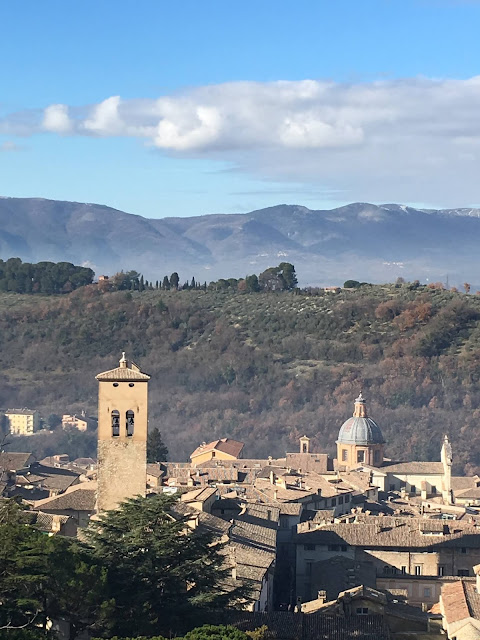Umbria is known as "The green heart of Italy" where the pig and truffle are kings of the forest. Ancient Roman ruins and Medieval hilltowns dot the countryside of this mystic region known for producing the most Saints in all of Italy. Here are my top 10 favourite Umbrian towns...
Assisi
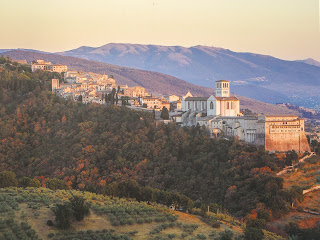 |
| Sunset In Assisi |
My number one pick for the top Umbrian town is Assisi. Assisi is not off the beaten path, but it is hands down my favourite city in all of Umbria. Assisi sits on the slopes of Monte Subasio facing West to capture what I think are the most sublime sunsets in all of Umbria. The Romans named this settlement Asisium in 295 BCE, and it thrived for centuries as part of a trade route to the Adriatic. There are many Roman ruins to be seen in Assisi such as a theatre, an amphitheatre, a Roman crypt under the church of St. Benedict and the Temple of Minerva which is now a Catholic church. There is also a Medieval castle called Rocca Maggiore perched at the top of Assisi that offers stunning views of the Umbrian countryside below. Piazza del Comune is considered the main square of Assisi and is where the Roman forum of Asisium once stood, and it is still under the streets.
 |
| Wandering The Streets Of Assisi |
The real attraction of Assisi is The Basilica of Saint Francis. The Basilica was built in the year 1228 as soon as Saint Francis was canonized. The highlight of this incredible basilica was the frescoes on the upper church walls depicting scenes from St. Francis' life by the master painter Giotto. The tomb of St. Francis is located in the lower level of the Basilica and is one of the most spiritually moving place for tourists and pilgrims alike. In the year 2000, the Basilica of Saint Francis became a UNESCO World Heritage site to help preserve the beauty and precious art within. The real charm of Assisi though is just wandering through the Medieval alleyways and soaking in the beautiful mix of stonework and flowers!
For more information on Assisi check out my blog post: Assisi, Umbria-A Pilgrims Paradise!
Orvietto
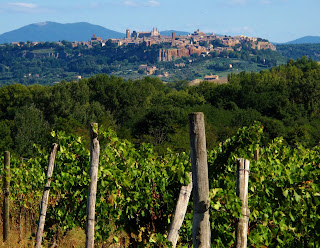 |
| Approaching Orvieto |
Set in a dry and arid valley surrounded by vineyards, Orvieto is a 3,000-year-old Etruscan town built on a giant tufa rock outcropping. Sitting 1,000 feet above the valley floor, Orvietto has a beautiful Gothic Cathedral and loads of underground Etruscan tombs. Imagine romantic strolls along the town ramparts with Umbrian views that stretch off into the distance. Not to mention Orvietto is the birthplace of a famous white wine called Orvietto Classico that has been made in Orvietto for millennia and was aged in the tufa caves as it still is today.
If you are interested in the mysterious Etruscan people, then Underground Orvieto or a visit to the unearthed Etruscan Necropolis (city of the dead) at the base of the cliff will pique your interest! What I loved best about Orvieto was that although the town was bustling with tourists all day, the evenings were full of locals out strolling for the evening passeggiata amongst the beautifully lit churches and palaces. Orvietto is an easy town to walk because you can not get lost; it's as if you are on an island made of tufa.
 |
| Orvieto's Glistening Duomo |
If you are interested in the mysterious Etruscan people, then Underground Orvieto or a visit to the unearthed Etruscan Necropolis (city of the dead) at the base of the cliff will pique your interest! What I loved best about Orvieto was that although the town was bustling with tourists all day, the evenings were full of locals out strolling for the evening passeggiata amongst the beautifully lit churches and palaces. Orvietto is an easy town to walk because you can not get lost; it's as if you are on an island made of tufa.
Spoleto
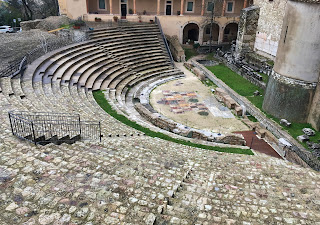 |
| Spoleto's Roman Theatre |
Spoleto is nestled in the foothills of the Apennine mountains along the ancient Roman road called the Via Flaminia that stretches from Rome to Ravenna on the Adriatic Sea. Once known as Spoletum by the Ancient Romans, Spoleto still boasts many Roman ruins like a theatre, the ancient city wall, a forum with temples and an incredible ancient aqueduct called the Ponte Delle Torri. Spoleto is a town of 20,000 inhabitants that is relatively unknown to North Americans, yet is known throughout Italy for it's two acclaimed summer arts festival: The Spoleto Jazz Festival and "Festival Dei Due Monde" or Festival Of The Two Worlds arts festival. These festivals give the small town of Spoleto an international and artsy feel.
 |
| Ponte della Torre |
Perched at the very top of Spoleto is "The Rocca" or castle Albornoziana sits like a giant crown atop the town. There are sets of escalators and elevators built inside the mountain all leading up to the Rocca to help people navigate this verticle city. The views of Spoleto and the surrounding Umbrian mountains from the castle ramparts are phenomenal.
Spoleto offers the best Umbrian wines, wild game and fresh local produce of the region with an abundance of trattorias and Enoteca to choose from. For more on Spoleto check out my blog post: Wonders Of Spoleto
Spello
 |
| Stroll To Spello's Belvedere |
Spello is like a quaint miniature version of Spoleto. This little Umbrian village is also located on the slopes of Mount Subasio, just ten kilometres (six miles) South of Assisi, yet it misses most of the tourist traffic. Just like Spoleto, Spello is on the Via Flaminia which is the ancient Roman road to the Adriatic. Roman city walls with five huge gates called Porta surround the hilltown; evidence of Spello's Roman roots. There are enough Roman gates, arches, churches and aqueducts to keep you exploring all day long, and when you are done there are some fabulous restaurants to keep you well-fed.
Here in tiny Spello's main square, the Renaissance master Pinturiccio painted the Baglioni Chapel in the Cathedral of Santa Maria Maggiore in 1500. It is worth it to pop into the church and marvel at the divine frescoes. A climb to the top of this delightful hamlet is a must. Via Cappuccini leads to a large west-facing belvedere overlooking the valley. You can see Bevagna on the valley floor and Assisi spilling down the nearby mountainside. This is such an inspiring spot to sit and rest for a while, watch the Umbrian sunset and let the world go by. For more on Spello see my blog post: The Via Flaminia To Spello.
Narni
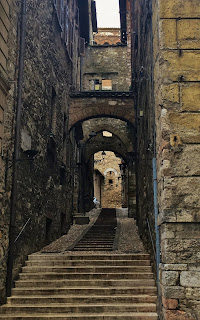 |
| Medieval Streets Of Narni |
Suspended on the cliffside above a grand valley, Medieval looking Narni is much older than the Roman remains here. Narni looks like a Medieval warren of stairways and cobbled alleyways with one flat main street down the centre of town. The main road of Narni is broad and was once the Roman Forum, and most of the Romanesque churches are built on top of Roman Temples.
There are lots of activities in Narni: museums, ancient churches with incredible frescoes that date back to St Francis's time. For the adventurous, try Narni Underground tours, or the Rocca Albornoz of Narni which is a big castle on the very top of the hill above the town. Just outside of Narni there is the Benedictine Abbey of San Cassiano which dates back to the 10th century. There is a branch of the University of Perugia here in Narni, imbuing lively and youthful energy into the hilltop town with great bars, cafes and restaurants.
To get to Narni follow the SR3 from Rome through the mountainous countryside. There are many great places to eat in Narni, but we found a haven at Hosteria La Bottega del Giullare. The dishes here are traditional local fare, all made from scratch and the local house red wine was SO delicious. For more information on Narni see my blog post: The Via Flaminia to Narni, Umbria
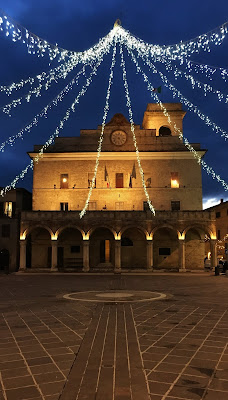 |
| Montefalco's Main Square |
Montefalco
Montefalco is kind of the Montalcino, Tuscany of Umbria. What I mean by that is: Montefalco is a charming hill town surrounded by undulating hills covered by grapevines that serves the best wine of the region-just like Montalcino, Tuscany. Except Montefalco is relatively undiscovered by North Americans! While Montalcino owns it's red wine superstar the famous Brunello; Montefalco has Sagrantino. Sagrantino translated from Latin means sacred wine, and there are strong theories that St. Francis and his gang brought these vines from the Holy Lands because the Sagrantino grape does not share any commonalities with any other grape variety grown in central Italy. To read about this fascinating wine read my blog post: The Mysterious Sagrantino
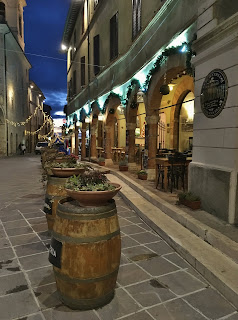 |
| Street Scene In Montefalco |
Montefalco was inhabited by the Etruscan people, the Umbri people, the Romans and then finally Frederick II took over in 1249 and city built massive city walls that housed a protective fortress.
Follow the streets upwards to a beautiful Renaissance piazza, Piazza del Commune which is the most open and airy piazza in all of Umbria. Surrounded by former palazzos that are now restaurants, cafes and enoteca, this is the perfect place to stop and have a glass of the famous Sagrantino wine. A walk along the ramparts of Montefalco reveal you can see all the way to Assisi, Spello, Trevi, Todi, Bevagna, Perugia and Spoleto! Montefalco is my vote for the most central town to stay at while exploring the rest of Umbria. For more information on Montefalco read my blog post: Montefalco, Umbria
Gubbio
 |
| Palazzo dei Consoli |
Set in the foothills of Northern Umbria's Apennine Mountains, Gubbio is another hill town along the ancient Roman road, The Via Flaminia the leads from Rome to Rimini. Gubbio is nestled on the lower slopes of Mount Ingino, with its ominous looking grey limestone buildings winding up the densely treed mountainside. Another Medieval wonderland, Gubbio is full of imposing palaces, narrow arched alleyways and lots and LOTS of stairs. There are many traces of the ancient Roman ruins here, like the city walls, the city gates and an amphitheatre, but the early Medieval architecture is the real draw to Gubbio. The Via della Repubblica goes uphill through town to the main piazza with the Medieval Palazzo de Consoli. Check out the views of the Umbrian countryside from the walls of this gorgeous square. Gubbio also has a venerable ceramics museum and is an excellent place to pick up some pottery to bring home. Head farther up the hill to Via San Gerolamo where you will come across a mini-funicular with little two-person baskets that can whisk you up to the top of the hill to the Basilica of Ubaldo. The Umbrian views from the Basilica are absolutely awe-inspiring. For more information on Gubbio, including where to dine, check out my blog post on New Year's Eve in Gubbio
Todi
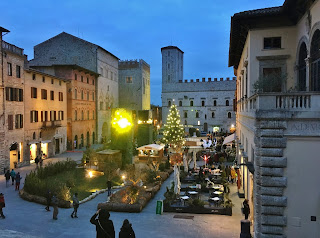 |
| Piazza del Popolo |
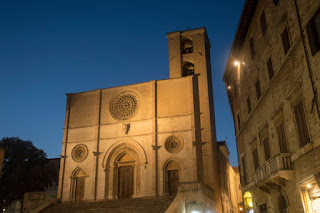 |
| Duomo of Todi |
Todi has a beautiful main piazza called Piazza del Popolo that was built on top of the Roman forum. This Piazza is surrounded by imposing Medieval fortresses on three sides and a beautiful Duomo on one end. What makes Todi's Piazza so impressive is that all the palaces were built within 150 years of each other, giving the square an analogous feel. In fact, Todi is very popular as a movie set for films depicting the middle ages. For stunning views of the Umbrian countryside climb up the Duomo's bell tower and marvel at the tranquil vineyards and villas that surround you. For more information on Todi check out my blog post titled: Todi, A Medieval Wonderland
 |
| Evening Views From Todi's Piazza Garibaldi |
Deruta
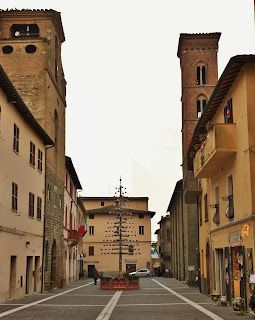 |
| Renaissance Deruta |
 |
| Deruta's Ceramics Are Everywhere |
This meant that Deruta was constantly being sacked by wars and plagues from post-Roman times through the Middle Ages. It wasn't until the Renaissance that Deruta became stable and known for producing the best quality ceramics in Italy. Therefore all the architecture in Deruta harkens from this era, and there are some beautiful churches and piazzas to explore.
Many of the ceramics styles and designs that were created in the Renaissance are still sold in Deruta's shops today, such as the famous "Raffaellesco" style painted pottery which is the trademark of Deruta ceramics. Many of Deruta's ceramics factories are located in the "new town" at the foot of Deruta and often offer better prices than the small touristy boutiques on the hilltop. Yet there are some very unique shops in the Centro Storico or "old town" that have bee run by the same family for generations, handed down from mother to daughter. All the shops offer hand-painted ceramics that are slightly different in design and colour, so it's fun to wander around the stores and see the various artists' styles. For more information on all that Deruta has to offer, check out this blog post: The Hilltown of Deruta; Ceramic Heaven!
If you want to get off the beaten tourist path and see the most charming lakeside Umbrian town with hardly any tourists, then head to the border of Umbria and Tuscany to Castiglione del Lago. The city's name means "Lion Castle of the Lake" because there is a vast star-shaped castle called Fortress of The Lion that is perched high above the shores of Lake Trasimeno. Wandering through the Roman gates and along the Corso, you are running the gauntlet of Umbrian specialty foods, featuring all kinds of dried pasta, dried porcini mushrooms, truffles, sundried tomatoes, spices, wines, olive oils and of course the wild boar sausage called Salumi di Chingiale.
Follow the Corso past delightful terraced restaurants and you come to a Renaissance palazzo with beautifully painted frescoes. This palazzo is now the city hall, and it is connected to the castle by a long covered corridor. The fortress is a blast to explore, and kids can run wild upon the ramparts while the adults take in the gorgeous views of Lake Trasimeno. Castiglione del Lago is easy to navigate by foot and is governed by the rule of three: three ancient city gates, three piazzas, and three churches. The Church of Santa Maria Maddalena with its large Roman columns is worth a peek inside for the Baroque style and frescoes. For more photos and information on Castiglione del Lago, see my blog post: Castiglione Del Lago~Perfect Family Destination In Umbria
Castiglione Del Lago
 |
| Porta Senese |
If you want to get off the beaten tourist path and see the most charming lakeside Umbrian town with hardly any tourists, then head to the border of Umbria and Tuscany to Castiglione del Lago. The city's name means "Lion Castle of the Lake" because there is a vast star-shaped castle called Fortress of The Lion that is perched high above the shores of Lake Trasimeno. Wandering through the Roman gates and along the Corso, you are running the gauntlet of Umbrian specialty foods, featuring all kinds of dried pasta, dried porcini mushrooms, truffles, sundried tomatoes, spices, wines, olive oils and of course the wild boar sausage called Salumi di Chingiale.
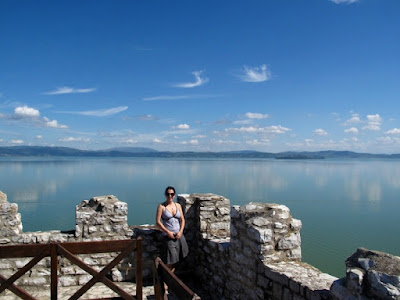 |
| Views of Lake Trasimeno From The Castle Ramparts |
Follow the Corso past delightful terraced restaurants and you come to a Renaissance palazzo with beautifully painted frescoes. This palazzo is now the city hall, and it is connected to the castle by a long covered corridor. The fortress is a blast to explore, and kids can run wild upon the ramparts while the adults take in the gorgeous views of Lake Trasimeno. Castiglione del Lago is easy to navigate by foot and is governed by the rule of three: three ancient city gates, three piazzas, and three churches. The Church of Santa Maria Maddalena with its large Roman columns is worth a peek inside for the Baroque style and frescoes. For more photos and information on Castiglione del Lago, see my blog post: Castiglione Del Lago~Perfect Family Destination In Umbria
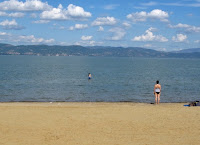 |
| Glorious Beaches |
There is also a promenade along the lakefront that meanders past beautiful public parks and beaches. This would be an idyllic place for an Umbrian picnic of some olives, pecorino cheese, fresh figs with honey, wild boar salami and of course a bottle of Umbrian wine. Check out this blog post: The Wines of Umbria to get an idea of the great variety of top-notch wines available in Italy.
Civita di Bagnoregio
 |
| Civita di Bagnoregio |
Ok, you got me here; Civita di Bagnoregio while less than half an hour drive South from Orvietto is actually NOT in Umbria but just across the border in the Region of Lazio. This little hamlet (now almost a ghost town) was once a prosperous Medieval town sitting on a tufa perch in the middle of a canyon. Civita di Bagnoregio is named "la città che muore" or "the dying town" because the village started sliding off the cliffs after an earthquake in 1695, and a new town for the residents was built, leaving the historical center of Civita di Bagnoregio to the day-trippers and the cats.
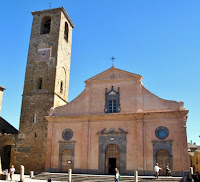 |
| Church In The Main Piazza |
A footbridge leads from Bagnoregio across to the unspoiled Middle-Aged village that was settled by the Etruscans and then the Romans. The archway that you pass through to enter Civita was carved by the Etruscans 2,500 years ago and the pillars in front of the church were once part of an Etruscan temple and then a Roman temple! There are also some Renaissance-style palaces mixed in the jumble of buildings perched on top of the rock. Wandering to the far end of town the road turns into a path that heads down into the valley far below. Here you will see some Etruscan caves that were used until recently as animal stables and also an interesting early Christian church in a cave. For more information on Civita di Bagnoregio, I invite you to check out my blog post: Italian Ghost Town Civita di Begnoregio
The traffic-free wandering around in Civita is so relaxing, and marvelling at the beautiful flowers and architecture of the village that epitomizes small hilltown Italy. Grab a coffee or some lunch, pet some cute kitties, listen to the crickets and take loads of pictures. This town is best admired when you have no agenda and lots of curiosity.
Follow me on FACEBOOK, INSTAGRAM and BLOGLOVIN' for daily photos and updates! #slowtravel🐌
The traffic-free wandering around in Civita is so relaxing, and marvelling at the beautiful flowers and architecture of the village that epitomizes small hilltown Italy. Grab a coffee or some lunch, pet some cute kitties, listen to the crickets and take loads of pictures. This town is best admired when you have no agenda and lots of curiosity.
 |
| Enjoying Lunch Alfresco |
Umbria is Tuscany's rough and rustic cousin, and if you are searching for an authentic Italy with gorgeous hilltowns and delicious food, then Umbria is your next destination! If you have a favourite Umbrian town, let me know in the comments below.
Follow me on FACEBOOK, INSTAGRAM and BLOGLOVIN' for daily photos and updates! #slowtravel🐌
